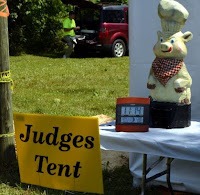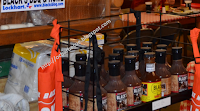 |
| Louis Hughes, circa 1897. From Thirty Years a Slave from Bondage to Freedom. |
Louis Hughes (1832–1913) was born enslaved near Charlottesville, Virginia. He escaped slavery during the Civil War. In 1897, Hughes published his autobiography titled Thirty Years a Slave from Bondage to Freedom: The Institution of Slavery as Seen on the Plantation and in the Home of the Planter that was prefaced with the following:
The institution of human slavery, as it existed in this country, has long been dead; and, happily for all the sacred interests which it assailed, there is for it no resurrection. It may, therefore, be asked to what purpose is the story which follows, of the experiences of one person under that dead and accursed institution? To such question, if it be asked, it may be answered that the narrator presents his story in compliance with the suggestion of friends, and in the hope that it may add something of accurate information regarding the character and influence of an institution which for two hundred years dominated the country - exercising a potent but baneful influence in the formation of its social, civil and industrial structures, and which finally plunged it into the most stupendous civil war which the world has ever known. As the enlightenment of each generation depends upon the thoughtful study of the history of those that have gone before, everything which tends to fullness and accuracy in that history is of value, even though it be not presented with the adjuncts of literary adornment, or thrilling scenic effects.Hughes left us a remarkably detailed record of his life and experiences. He also left us the following detailed account of antebellum Independence Day Barbecues.
A feast of this kind was always given to us, by Boss, on the 4th of July. The anticipation of it acted as a stimulant through the entire year. Each one looked forward to this great day of recreation with pleasure. Even the older slaves would join in the discussion of the coming event. It mattered not what trouble or hardship the year had brought, this feast and its attendant pleasure would dissipate all gloom. Some, probably, would be punished on the morning of the 4th, but this did not matter; the men thought of the good things in store for them, and that made them forget that they had been punished. All the week previous to the great day, the slaves were in high spirits, the young girls and boys, each evening, congregating, in front of the cabins, to talk of the feast, while others would sing and dance. The older slaves were not less happy, but would only say: "Ah! God has blessed us in permitting us to see another feast day."
The day before the 4th was a busy one. The slaves worked with all their might. The children who were large enough were engaged in bringing wood and bark to the spot where the barbecue was to take place. They worked eagerly, all day long; and, by the time the sun was setting, a huge pile of fuel was beside the trench, ready for use in the morning. At an early hour of the great day, the servants were up, and the men whom Boss had appointed to look after the killing of the hogs and sheep were quickly at their work, and, by the time they had the meat dressed and ready, most of the slaves had arrived at the center of attraction. They gathered in groups, talking, laughing, telling tales that they had from their grandfather, or relating practical jokes that they had played or seen played by others. These tales were received with peals of laughter. But however much they seemed to enjoy these stories and social interchanges, they never lost sight of the trench or the spot where the sweetmeats were to be cooked.
The method of cooking the meat was to dig a trench in the ground about six feet long and eighteen inches deep. This trench was filled with wood and bark which was set on fire, and, when it was burned to a great bed of coals, the hog was split through the back bone, and laid on poles which had been placed across the trench. The sheep were treated in the same way, and both were turned from side to side as they cooked. During the process of roasting the cooks basted the carcasses with a preparation furnished from the great house, consisting of butter pepper, salt and vinegar, and this was continued until the meat was ready to serve. Not far from this trench were the iron ovens, where the sweetmeats were cooked.
Three or four women were assigned to this work. Peach cobbler and apple dumpling were the two dishes that made old slaves smile for joy and the young fairly dance. The crust or pastry of the cobbler was prepared in large earthen bowls, then rolled out like any pie crust, only it was almost twice as thick. A layer of this crust was laid in the oven, then a half peck of peaches poured in, followed by a layer of sugar; then a covering of pastry was laid over all and smoothed around with a knife. The oven was then put over a bed of coals, the cover put on and coals thrown on it, and the process of baking began. Four of these ovens were usually in use at these feasts, so that enough of the pastry might be baked to supply all. The ovens were filled and refilled until there was no doubt about the quantity. The apple dumplings were made in the usual way, only larger, and served with sauce made from brown sugar. It lacked flavoring, such as cinnamon or lemon, yet it was a dish highly relished by all the slaves.
I know that these feasts made me so excited, I could scarcely do my house duties, and I would never fail to stop and look out of the window from the dining room down into the quarters. I was eager to get through with my work and be with the feasters. About noon everything was ready to serve. The table was set in a grove near the quarters, a place set aside for these occasions. The tableware was not fine, being of tin, but it served the purpose, and did not detract from the slaves' relish for the feast. The drinks were strictly temperance drinks - buttermilk and water. Some of the nicest portions of the meat were sliced off and put on a platter to send to the great house for Boss and his family.
It was a pleasure for the slaves to do this, for Boss always enjoyed it. It was said that the slaves could barbecue meats best, and when the whites had barbecues slaves always did the cooking. When dinner was all on the table, the invitation was given for all to come; and when all were in a good way eating, Boss and the madam would go out to witness the progress of the feast, and seemed pleased to see the servants so happy. Everything was in abundance, so all could have plenty - Boss always insisted on this. The slaves had the whole day off, and could do as they liked.
After dinner some of the women would wash, sew or iron. It was a day of harmless riot for all the slaves, and I can not express the happiness it brought them. Old and young, for months, would rejoice in the memory of the day and its festivities, and "bless" Boss for this ray of sunlight in their darkened lives.





































